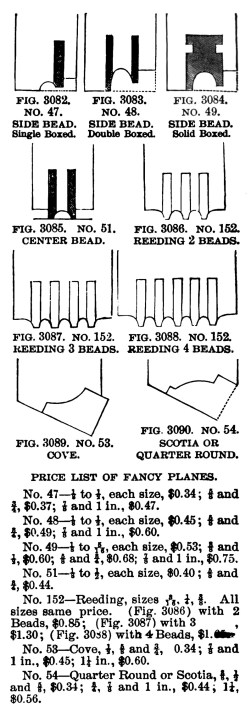
Under the above heading there comes what are known as Fancy Planes. There are several manufacturers in this country who make these lines of Planes. Some make better planes than others and we try to procure the best. None of the American makes equal those of the best English and Scotch makers. The Englishman said of American beer, ‘They cawn’t make it you know, they aven’t the Ops,” and perhaps this is true of Moulding Planes, ”We haven’t the Beech you know.” As a matter of fact, for Moulding Planes, Spoke Shaves and similar tools the English and Scotch beechwood is greatly superior to the American, and the best Moulding Planes we have ever seen are those made by Mathieson, of Glasgow, Scotland.
While to a great extent the Combination Planes like the No. 45 are taking the place of the Moulding Planes, they do not by any means cover the entire ground. Where a considerable quantity of a certain kind of work is to be done, the Wood Planes are so much lighter and so much more convenient to handle, that it is not always the best economy to use a Combination Plane for this class of work.
We recently had an instance of this. A mechanic in boasting about the merits of his Combination Plane (a No. 45) stated that he had beaded 5,000 ft. of ceiling on a summer hotel job upon which he had been employed. We did not consider that this was very much to boast of, and think that any man who would use a plane weighing 3 ½ lbs. for six or eight days, when he might have bought a 1 Inch Bead Plane, weighing about 10 ounces, for 40 cents, and with it have done the work in 15 to 25 per cent less time, and with correspondingly less expenditure of strength, is rather closely related to that useful— though humble — animal, with kicking proclivities, long ears, and an unmusical voice.
The lines of Miscellaneous Planes shown here we usually carry in stock. Can furnish other sizes than those given here in many of the styles. Special sizes cost more, it takes time to procure them, and we would suggest that the stock—or listed—sizes be used whenever possible.
Chas. A. Strelinger & Co. – Detroit, Michigan 1897
– Jeff Burks








